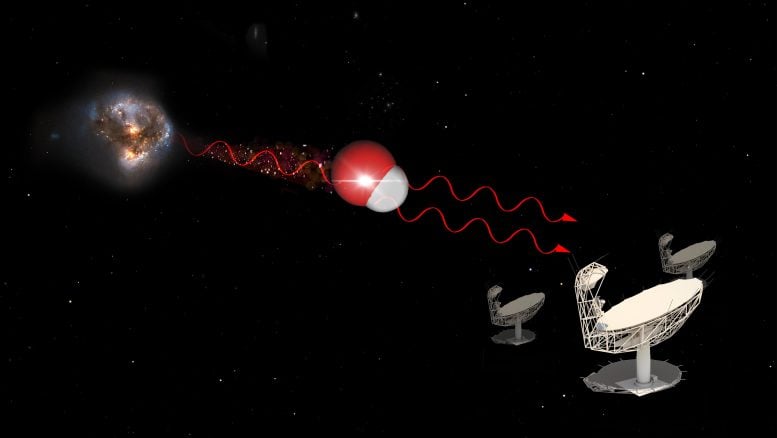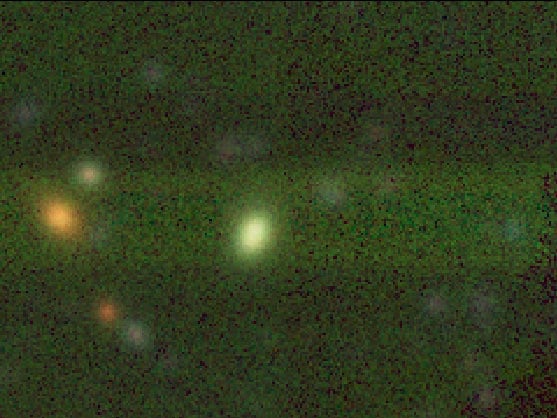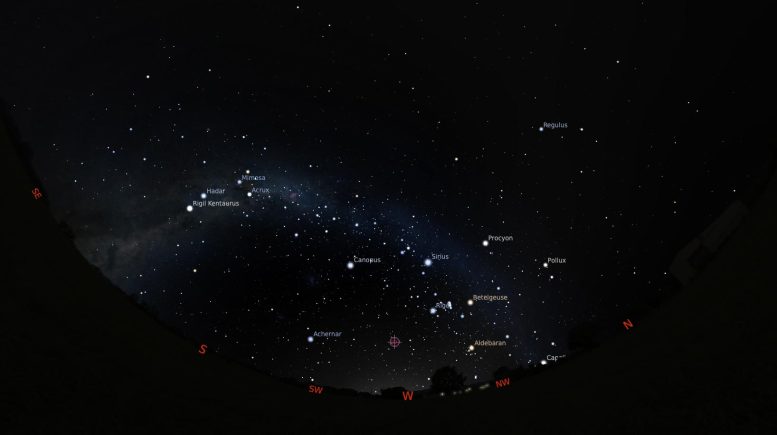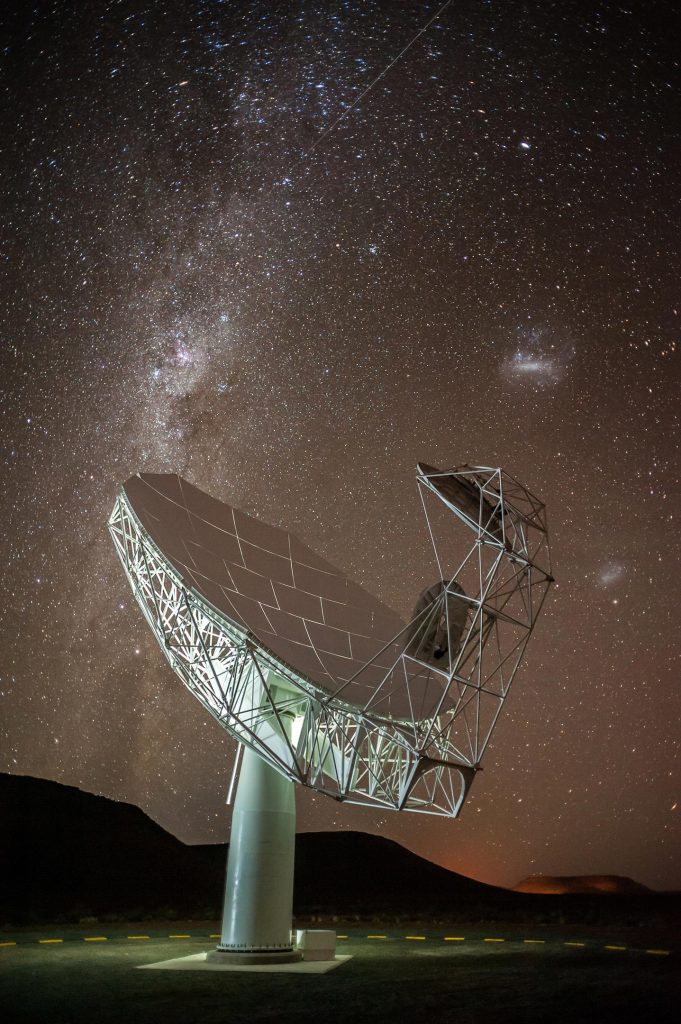
Inside a galaxy merger are hydroxyl molecules, composed of one atom of hydrogen and one atom of oxygen. When one molecule absorbs a photon at an 18cm wavelength, it emits two photons of the same wavelength. When molecular gas is very dense, typically when two galaxies merge, this emission gets very bright and can be detected by radio telescopes such as the MeerKAT. Credit: © IDIA/LADUMA using data from NASA/StSci/SKAO/MolView
The MeerKAT telescope in South Africa has discovered a strong radio-wave laser known as a ‘megamaser.’
At nearly five billion light-years from Earth, the record-breaking discovery is the most distant megamaser yet discovered.
The light from the megamaser has traveled 58 thousand billion billion (58 followed by 21 zeros) kilometers to reach the Earth.

The three-color optical image of the host galaxy of the hydroxyl megamaser, taken from the Hyper Suprime-Cam (HSC) on the 8.2 m Subaru Telescope. Credit: Subaru Telescope
Dr. Marcin Glowacki, who formerly worked at the Inter-University Institute for Data Intensive Astronomy and the University of the Western Cape in South Africa, led an international team of astronomers in making the finding.
Megamasers are often formed when two galaxies collide violently in the Universe, according to Dr. Glowacki, who is currently stationed at the Curtin University node of the International Centre for Radio Astronomy Research (ICRAR) in Western Australia.
“When galaxies collide, the gas they contain becomes extremely dense and can trigger concentrated beams of light to shoot out,” he said.
“This is the first hydroxyl megamaser of its kind to be observed by MeerKAT and the most distant seen by any telescope to date.
“It’s impressive that, with just a single night of observations, we’ve already found a record-breaking megamaser. It shows just how good the telescope is.”
The record-breaking object was named ‘Nkalakatha’ [pronounced ng-kuh-la-kuh-tah]—an isiZulu word meaning “big boss.”
Dr. Glowacki said the megamaser was detected on the first night of a survey involving more than 3000 hours of observations by the MeerKAT telescope.
The team is using MeerKAT to observe narrow regions of the sky extremely deeply and will measure atomic hydrogen in galaxies from the distant past to now. The combination of studying hydroxl masers and hydrogen will help astronomers better understand how the Universe has evolved over time.
“We have follow-up observations of the megamaser planned and hope to make many more discoveries,” Dr. Glowacki said.
MeerKAT is a precursor instrument for the Square Kilometer Array—a global initiative to build the world’s largest radio telescopes in Western Australia and South Africa.

Nkalakatha’s host galaxy as viewed from Perth, Western Australia. It’s ~5 billion light years away and invisible to the naked eye, between Archernar and Aldebaran. Credit: ICRAR
Reference: “LADUMA: Discovery of a luminous OH megamaser at z>0.5” by Marcin Glowacki, Jordan D. Collier, Amir Kazemi-Moridani, Bradley Frank, Hayley Roberts, Jeremy Darling, Hans-Rainer Klöckner, Nathan Adams, Andrew J. Baker, Matthew Bershady, Tariq Blecher, Sarah-Louise Blyth, Rebecca Bowler, Barbara Catinella, Laurent Chemin, Steven M. Crawford, Catherine Cress, Romeel Davé, Roger Deane, Erwin de Blok, Jacinta Delhaize, Kenneth Duncan, Ed Elson, Sean February, Eric Gawiser, Peter Hatfield, Julia Healy, Patricia Henning, Kelley M. Hess, Ian Heywood, Benne W. Holwerda, Munira Hoosain, John P. Hughes, Zackary L. Hutchens, Matt Jarvis, Sheila Kannappan, Neal Katz, Dušan Kereš, Marie Korsaga, Renée C. Kraan-Korteweg, Philip Lah, Michelle Lochner, Natasha Maddox, Sphesihle Makhathini, Gerhardt R. Meurer, Martin Meyer, Danail Obreschkow, Se-Heon Oh, Tom Oosterloo, Joshua Oppor, Hengxing Pan, D. J. Pisano, Nandrianina Randriamiarinarivo, Swara Ravindranath, Anja C. Schröder, Rosalind Skelton, Oleg Smirnov, Mathew Smith, Rachel S. Somerville, Raghunathan Srianand, Lister Staveley-Smith, Masayuki Tanaka, Mattia Vaccari, Wim van Driel, Marc Verheijen, Fabian Walter, John F. Wu and Martin A. Zwaan, 19 May 2022, The Astrophysical Journal Letters.
DOI: 10.3847/2041-8213/ac63b0
arXiv:2204.02523
Inter-University Institute for Data Intensive Astronomy
The Inter-university Institute for Data Intensive Astronomy is a partnership of three South African universities, the Universities of Cape Town, of the Western Cape and of Pretoria as well as the South African Radio Astronomy Observatory. The overarching goal of IDIA is to build within the South African university research community the capacity and expertise in data intensive research to enable global leadership on MeerKAT large survey projects and large projects on other SKA pathfinder telescopes.
ICRAR
The International Centre for Radio Astronomy Research (ICRAR) is a joint venture between Curtin University and The University of Western Australia with support and funding from the State Government of Western Australia.
MeerKAT
The South African MeerKAT radio telescope, situated 90 km outside the small Northern Cape town of Carnarvon, is a precursor to the Square Kilometer Array (SKA) telescope and will be integrated into the mid-frequency component of SKA Phase 1. The MeerKAT telescope is an array of 64 interlinked receptors (a receptor is the complete antenna structure, with the main reflector, sub-reflector and all receivers, digitizers, and other electronics installed). The MeerKAT is built and operated by the South African Radio Astronomy Observatory.
The Square Kilometer Array
The Square Kilometer Array (SKA) project is an international effort to build the world’s largest radio telescope, with eventually over a square kilometer (one million square meters) of collecting area.










So what your trying to tell me is that humans have NO CLUE were we came from, NO clue why we are here, and absolutely no clue where we are going, and we’ve only been here for, say, for laughs, 1 million years.
But your telling me you can see into the future, where no one man will ever be able to go, so far away that god himself has a vacation home there????….i admit im as dumb as they come, BUT I aint stupid..8 billion people on the earth, im sure youll have enough believers to be justified as news…lololol